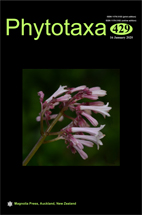Abstract
Carex retrofracta is a sedge belonging to section Confertiflorae and endemic from eastern to south-western China. Based on a comparison of the type specimens for Carex purpureotincta, C. haematorrhyncha (C. purpureotincta var. sphaerocarpa), C. xiangxiensis and C. retrofracta, and an analysis of morphological and molecular variation within and among populations, we could not find consistent diagnostic characters to differentiate all four of these putative species. Consequently, all of these taxa are considered to be conspecific and reduced to synonym of Carex retrofracta, the oldest name among them, expanding the distribution of this species to the provinces of Anhui, Guangxi, Guizhou, Hubei, Hunan, Sichuan, Taiwan and Zhejiang. Populations from southern Hunan and northern Guangxi were found to be distinct from the other samples of Carex retrofracta in both morphological and molecular data, and are described here as a new subspecies, which differs from C. retrofracta in having glabrous leaves and shorter perigynia.

